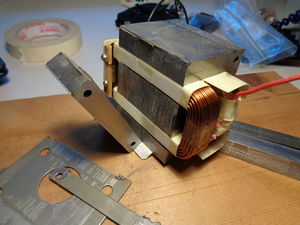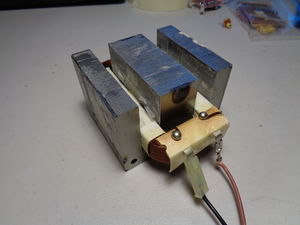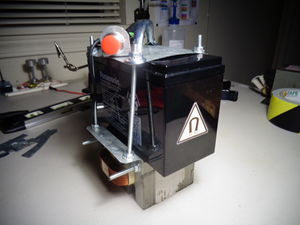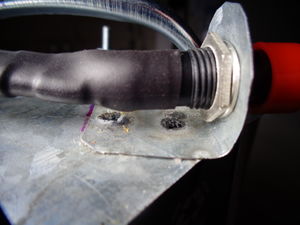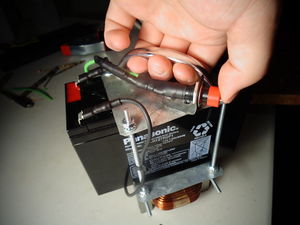Electromagnet 01
Of the many things you can build from a microwave oven, an electromagnet is one of the coolest and, potentially, the most useful. My goal here was to create a powerful, portable, hand-held electromagnet. Personally, I don't have a purpose for it; it's just a novelty device. That doesn't mean building one of these is completely useless. Something like this could be attached to a long handle and used to clean up magnetic material from a shop floor. An electromagnet would be particularly convenient over a "permanent" magnet because you can turn it off allowing the material to drop into a container. Saving your nuts and bolts is better than throwing them away, and a tool for picking them up is nice when you have a bad back. It's also a safer way to handle sharp metal turnings/scrap.
Another thing I did in this project was compare the effectiveness of AC current versus DC current for running the electromagnet. My hypothesis was that AC current would be less effective because the magnetic field would be constantly expanding and collapsing as the polarity of the current reversed directions 120 times per second (60 Hz). My observation was that it was, indeed, less effective and the vibration it created was an indication of the rapidly fluctuating magnetic field. In fact, when I lifted a heavy weight it felt like it was dropping the object and very quickly catching it again.
Video
Project Log
First, cut open the iron core of the Microwave Oven Transformer (MOT) along the welds, separating the "E" shaped piece. Pull out the two coils. The primary coil (the one with the thicker wire) is the one we need later, so be gentle with it! Don't scratch the copper because, although it looks like bare copper, it actually has a clear enamel coating on it that protects it from shorting out on the iron core or internally (between two points within the coil).
Mix some two-part epoxy and secure some of the loose layers of the core so they don't vibrate or fall off. Now put the primary coil back into the core. Keep the paper protectors on it. If you ruined the paper protectors, cut some strips of paper and wrap them around the coil. You don't want the coil to come in contact with the iron core.
If you watch the video, you'll notice that I spent some time experimenting with mains AC power (power from the wall), but DO NOT DO THIS! It could easily kill you, and I did the experiment so that you don't have to.
The battery I used is a 12 volt sealed lead-acid battery. I got it from an Uninterruptable Power Supply (UPS). It doesn't matter which way you attach the battery to the leads on the coil. I wanted to make this thing portable, so I created a chassis with a handle and a button.
I used my home-made Spot Welder to weld on the button bracket (click the link to see more). The weld stronger than it looks. You'll also see some extra shrink-wrap tubing on the green wire on top: that's actually a connector that I can disconnect when I'm not using the magnet. I'd hate to accidentally bump the button and ruin nearby electronics. Why don't I just disconnect one of the connectors on the battery? Good question. I don't know what I was thinking. :P
This thing is surprisingly comfortable to hold, even while lifting heavy things. If you're wondering about charging the battery, just attach a battery charger using alligator clips to the battery terminals and you're good to go (connectors go positive-to-positive/negative-to-negative). I also have some instructions on making a Cheap Battery Charger (click the link).
To see my portable electromagnet in action, check out the video above or go to https://www.youtube.com/watch?v=9o61Rq3FwDs.
